|
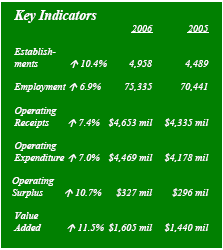 |
|
Source:
www.singstat.gov.sg
|
|
ECONOMIC SURVEYS SERIES
Reference Year 2006 |
|
Food and Beverage Services 2006 |
|
|
In 2006, the food & beverage (F&B) services
industry comprised about 5,000 establishments, up by 10.4 per cent
compared to 2005. The industry employed some 75,300 workers, or about 15
workers per establishment. |
|
I. ECONOMIC PERFORMANCE |
|
Total operating receipts
in the F&B services industry increased by 7.4 per cent in 2006, from
$4,335 million in 2005 to $4,653 million in 2006. The operating receipts
per establishment fell by 2.8 per cent from $965,600 in 2005 to $938,600
in 2006. |
|
Total operating expenditure
incurred was $4,469 million in 2006, 7.0 per cent higher compared with
the previous year. The F&B services industry incurred $1,539 million on
the purchases of goods, up by 4.3 per cent compared to 2005. The
remuneration expenditure increased by 11.3 per cent to $1,246 million in
2006. |
|
Total operating surplus
increased from $296 million in 2005 to $327 million in 2006,
representing a growth of 10.7 per cent. Operating surplus per
establishment increased marginally by 0.2 per cent to $66,000 in 2006. |
|
Total value added
recorded by F&B services industry was $1,605 million in 2006, an
increase of 11.5 per cent over 2005. The double digit growth was uniform
across the industry except for food caterers which experienced 2 per
cent growth. On a per establishment basis, value added increased by 0.9
per cent to $323,700 in 2006. |
|
II. MAIN TYPES OF FOOD & BEVERAGE
SERVICES |
|
Restaurants formed the largest group,
accounting for 30.3 per cent of the total establishments in food &
beverage services in 2006. They employed about 31,400 workers or 41.7
per cent of the total F&B workforce (Chart 1). |
|
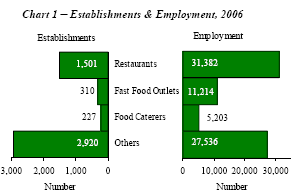 |
|
On a per establishment basis, fast food
outlets employed 36 workers, of which a large proportion were part-time
employees. Restaurants and food caterers employed an average of 21 and
23 workers on a per establishment basis. |
|
Restaurants generated total operating
receipts and value added of $1,811 million and $688 million in 2006.
These represented increases of 9.6% and 13.0% respectively over a year
ago. Restaurants accounted for 38.9 per cent of operating receipts and
42.9 per cent of value added for the F&B services industry (Chart 2).
Food caterers accounted for 13.0 per cent of operating receipts and 16.3
per cent of value added for the F&B services industry. |
|
 |
|
Purchases of goods, remuneration and rental
of premises were the top three business cost items for overall F&B
services in 2006 (Table 1). For restaurants and food caterers, about
two-thirds of total operating expenditure was incurred on purchases and
remuneration. Rental payment was the second largest cost item for fast
food outlets, accounting for 23.6 per cent of total operating
expenditure. |
|
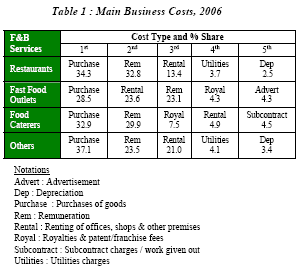 |
|
III. KEY PERFORMANCE RATIOS |
|
Profitability Ratio
of overall F&B services was 7.0 per cent in 2006, similar to the 6.8
per cent in 2005. Food caterers recorded the highest profitability
ratio of 16.9 per cent among all sectors in 2006 (Chart 3). However,
it was lower compared to 2005, mainly due to the higher remuneration
expenditure incurred. The profitability ratios of restaurants and
fast food outlets were both at 5.4 per cent. |
|
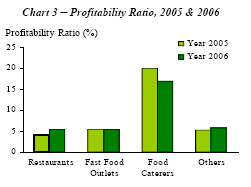 |
|
Cost Effectiveness
for overall F&B services was 7.3 per cent in 2006. Food caterers
were the most cost-effective, registering an earnings-expenditure
ratio of 19.6 per cent in 2006 (Chart 4), though lower than 2005.
Cost effectiveness ranged from 5.4 per cent to 5.9 per cent for
other sectors. |
|
 |
|
Average Annual Remuneration per Employee
increased by 3.7 per cent to $17,000 for F&B services industry in
2006. The average annual remuneration per employee was highest for
food caterers at $30,400 in 2006, up by 12.6 per cent over 2005
(Table 2). In contrast, average remuneration was lowest at $11,700
for fast food outlets, which employed a large number of part-timers. |
|
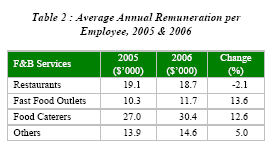 |
|
Value Added per Worker was $21,300 for
the overall F&B services in 2006. Within the industry, food caterers
generated the highest labour productivity of $50,300 (Chart 5) in
2006, an increase of 2.0 per cent compared to 2005. The other three
groups recorded lower value added per worker of $14,600 to $21,900. |
|
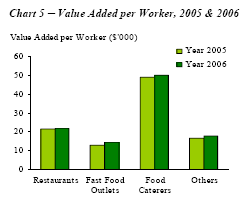 |
|
IV. PERFORMANCE BY FIRM SIZE |
|
The F&B industry comprised of 99.2 per
cent small and medium firms with less than 100 workers in 2006
(Table 3). These small and medium firms contributed 82.5 per cent
and 79.3 per cent of operating receipts and value added of the
industry. |
|
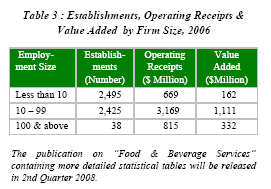 |
|
More..... |
|
Source:
www.singstat.gov.sg Media
Release 16 Apr 2008 |
|
 |
|
Important
Notice |
|
Our FrontPage
Editions are a historical record of our Web site and reflect
the changing of the times, and also of our Web site through
time. We do not and will not update the links and stories on
these FrontPages even if they have become obsolete. |
|